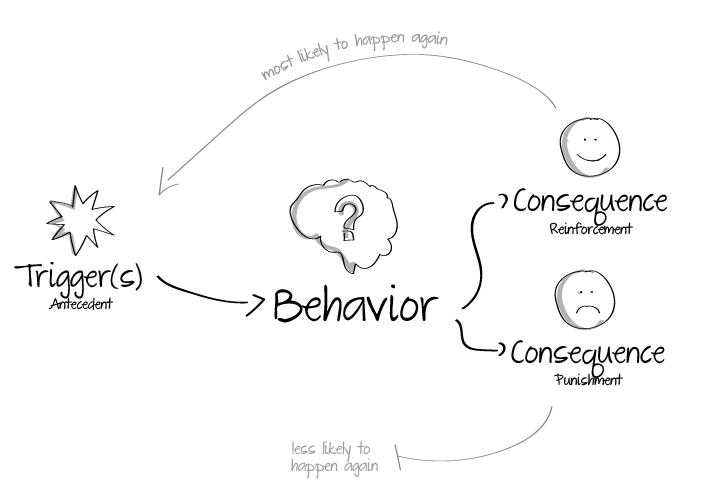A lot of first world problems we encounter today, like obesity, are due to behavioural factors that people are not aware of. People often think that raising awareness is enough to change unwanted or unhealthy behaviour. But in a world where information is everywhere all the time, awareness is not enough. We explored this field for a while now and we think the time is right to share our insights.
We can help people make better decisions by designing (digital) products and services that stimulate positive and healthy behaviour. This will only succeed with a design that is fun and easy to use. To achieve this we use a user-centered approach. Interaction designers play an important part in this. When designing for behaviour change we combine our knowledge of design with our knowledge of psychology and substantiate this with field research. We aim to explore what people think and do, but also why they do what they do. We achieve this by combining for example user safaris, emotion flows and user journeys, that are based on (field) research.
Our strength as interaction designers, is that we can tackle complex problems and use design to solve them. This works best in multidisciplinary agile teams with people from the field involved. They can provide you with a lot of information and ideas that you can use in your research. Start prototyping and testing at a very early stage to find out quickly what works and what doesn’t.
Why this is important for you
In order to design the best products and services, you need to know your users. Behaviour is everything that our job is about. But as designers we need building blocks to put this, mostly complex, behaviour theory into practice. While designing we discovered recurring behaviour challenges that needed similar solutions. We try to structure this knowledge in various behaviour patterns.
For example, if you’re designing for a public space and want people to be more active, you could design the stairs prominently and hide the elevators. Not the other way around. This pattern has proven to be successful more than once.
We want to share behaviour patterns like these. First on our blog, maybe later on a dedicated site. Just like we did before with our successful androidpatterns.com that still proves its value to over 1000 visitors a day.
If you want to change behaviour by design, you first have to know some basics (sorry, some theory needs to be involved).
An introduction to behaviour change
The problem with changing behaviour is that telling people how they should behave has little effect on how they actually behave. In short, behaviour is everything a person thinks, feels or does. It can be conscious or unconscious, visible or invisible and voluntary or involuntary.1 Every behaviour always has a trigger prior to it. This trigger can be anything, from a person to a thought, object or location. It will activate or prevent the behaviour.
Every behaviour also has a consequence. Rewarding a behaviour will encourage it again in the future and punishing it will make it less likely to happen again in future. If you want to change a behaviour, you thus have to change the trigger(s) and/or the consequence(s) of that behaviour.

We distinguish five different types of triggers that can start or prevent a behaviour. Namely tools, objects, the environment, social and processes. These triggers will be discussed extensively in the upcoming posts when we tell you about individual behaviour patterns.
Tools are an extension of the individual or group, for example a pedometer or a uniform.
Objects are an extension of the environment, for example a traffic light or a staircase.
The environment is everything that happens in the surroundings of a person, physical or virtual, for example music or trees.
Social is about a group or groups a person is part of, for example competing in rankings or testimonials.
Processes are mostly time based, for example a sequence or deadline.
Step by step
It’s very important to define a target behaviour up front. If you don’t know what behaviour you want to change, you can not anticipate and design directly on that behaviour. You have to define rules and goals to know when the target behaviour is reached or accomplished. Try to make these goals as clear as possible and make sure you can measure the result since this is the only way to know if you succeeded or not.
Then start looking at the triggers. Are there triggers that prevent the behaviour from happening? Or maybe some triggers maintain the unwanted behaviour. Determine what triggers are influencing the behaviour and then figure out how to use or change them with your design to reach your goals.
When the wanted behaviour has happened, or the unwanted behaviour is successfully prevented, you need to reward your user. Rewards can be anything. For example: a financial reward, points, status or just by making the user feel good. Direct and visible rewards (consequences) are more effective than less visible and long term rewards. That is why losing weight is so hard, because you won’t see any results on the short term.
When you combine the right triggers with the right consequences and repeat this, you’ll eventually create a habit.
An example
Billy is overweight. His doctor tells him he needs to lose weight if he wants to prevent health problems (knowledge). Therefore he needs to eat healthier and exercise more (behaviour). Then he will lose weight and prevent sickness (consequence). But as said earlier, this trigger (knowledge) will probably not be enough to get Billy moving or changing his diet. We have to find the right trigger(s) and reward(s) to get Billy moving and eating healthier. Or we have to remove triggers that cause the behaviour in the first place.
We first need to find out exactly why Billy is overweight. Let’s assume we did extensive research and found out he just doesn’t know how to eat healthy. Then we will, for example, remove all unhealthy food in Billy’s house, replace it with healthy food and provide easy-to-make healthy recipes. This will most likely help him eat healthier.
We also found out that Billy always takes his car to go to nearby places. To make him exercise more, we want him to take his bike more often. We have to find a way to make bike rides more fun and rewarding for Billy. Gamification is often used to solve problems like these. When he takes his bike instead of the car, we need to reward Billy with something that he likes, for example a good movie. Or when he took his bike three times, he is rewarded with a car ride next time. When we reward Billy’s good behaviour at the right way every time, he will repeat the behaviour. And when he repeats the behaviour often enough, he will eventually lose weight and become a healthier person.
This is of course a very obvious example. But it’s just to give you an idea of how triggers and consequences work. You will need a combination of different triggers and consequences to succeed.
That’s it!
Next time we will discuss the first behaviour design pattern, so you can see how this all comes together.
Got a question? Or interested in working with us on a design for behaviour challenge? Leave a comment or send us an e-mail.
Sources
1 Martin, Garry, en Joseph Pear. Behavior modification : what it is and how to do it. 9th revised. Harlow: Pearson Education, 2010.







